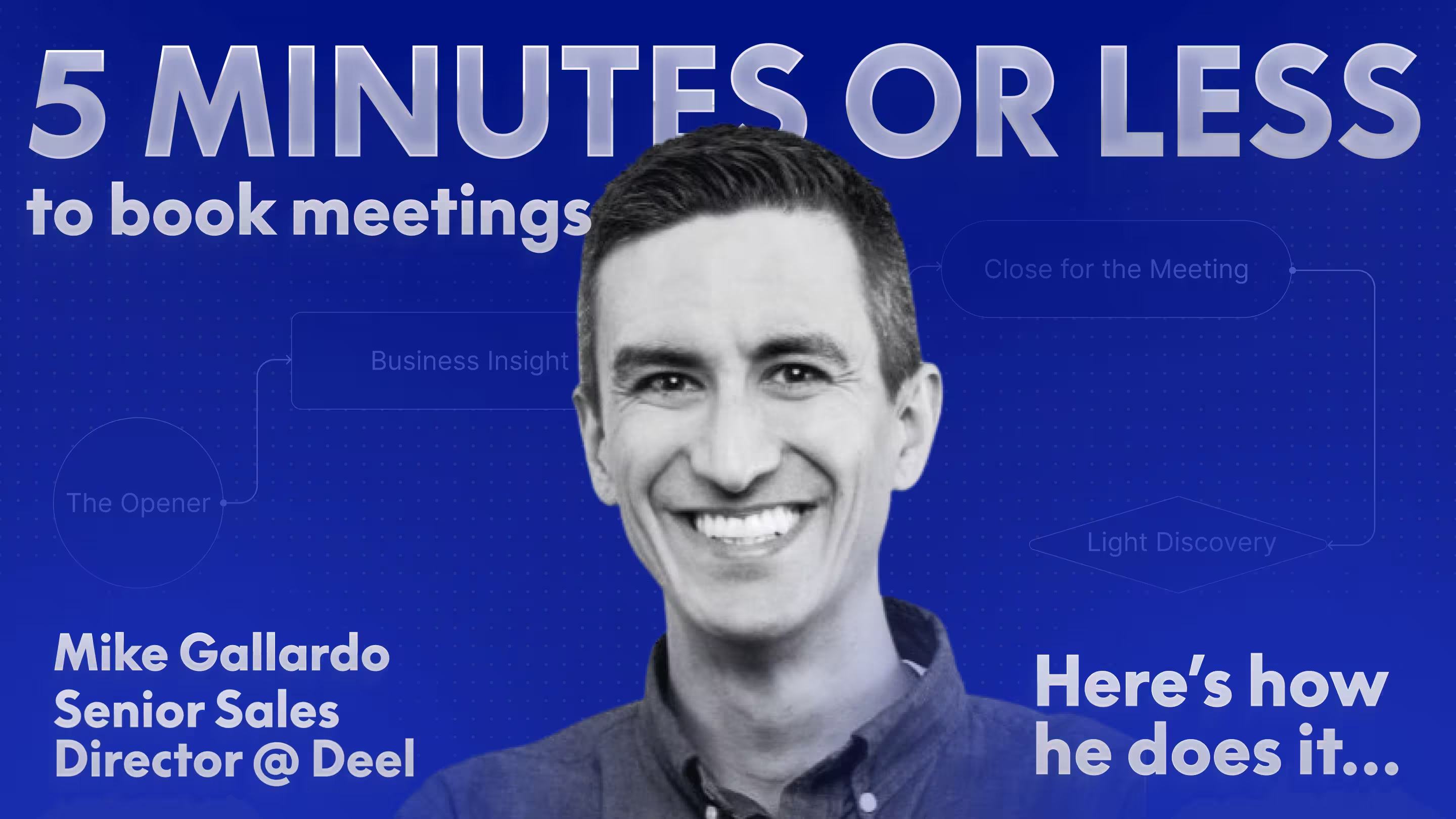Mike Gallardo's Cold Call Cheat Code Playbook

Overview
This playbook is built to help you book meetings in 5 minutes or less. It’s a simple, repeatable approach to cold calling. So you can grab attention fast, handle objections smoothly, and lock in that next step without overcomplicating things. I have taught these skills to thousands through my courses on LinkedIn and have seen countless SDRs and AEs increase their success on the phones and get promoted. Excited for you to share the success.
Call Flow Overview
- Opener
- Business insight
- Call-to-action (close for meeting)
- Light discovery (if time permits)
- Objection handling (if needed)
Step-by-Step Breakdown
Step 1: The Opener
The goal is to get permission to continue the conversation in a disarming, confident way.
Examples:
- "Hey [Name], it’s [You] from [Company]. I know this is a cold call. Do you have 30 seconds for me to tell you why I’m calling?"
- "Hey [Name], I’ll be upfront. This is a cold call about [value prop]. Can I have 30 seconds to explain why I’m reaching out to you specifically?"
- "Hey [Name], it’s [You] from [Company]. I know I caught you out of the blue. Mind if I take 30 seconds to tell you why I’m calling?"
- "Hi [Name], [You] from [Company] here. This is a cold call — would it be okay if I quickly shared why I thought it might be worth your time?"
Notes:
- Use a calm, steady tone. Sound like a peer. No uptalk or overly enthusiastic energy.
- Acknowledge the cold call. Don’t pretend it’s something it’s not. A simple, honest opener builds trust fast.
- Personalize just one thing. Name drop their company, a relevant stat, or a shared connection. Even small personalization can buy you 30 more seconds.
- Ask for time, not permission. Instead of “Is now a bad time?” try “Can I have 30 seconds?” It gives you control and feels respectful.
- Record yourself saying the opener until it sounds natural and is completely memorized.
Step 2: Business Insight
This is your hook. Speak to a real problem that your buyer is likely dealing with. Study calls with real customers and use their own words when describing their challenges.
Framework:
"Most [persona] I speak to are dealing with [challenge #1] or [challenge #2]. Curious if that’s your world too, or if something else is more top of mind?"
Example:
"Most sales leaders I speak to this time of year are under pressure to plan sales kick off but don’t have time to research destinations or align on budgets. Does that sound familiar or is something else taking priority right now?"
Why This Works:
- You sound like you know their world
- You show them you’re not just checking boxes
- You let them lead you to the real challenge
Step 3: Close for the Meeting
As soon as you hear something even mildly positive go for the meeting.
Framework:
"That’s actually something we help with. We worked with [company] to achieve [business result]. Would it make sense to book a quick call to show you how it works?"
Script:
"That’s actually something we help with. We worked with [company] and all they had to do was enter their team size and budget, and we gave them a full SKO breakdown with destinations, costs, and timeline in seconds. Would it make sense to book a quick call to show you how it works?"
Notes:
- The call should be booked within the first 4 to 5 minutes
- Sometimes calls go longer and that’s OK. But always remember that your job is not done until the meeting is booked. And oftentimes you can book that meeting as soon as there is interest by just asking for it.
Step 4: Light Discovery
Once a meeting is set, earn the right to ask a couple quick questions that will help your AE.
Examples:
- "While I have you, mind if I ask a quick question to prepare for our call tomorrow?"
- "Quick one while I’ve got you. Can I ask something to prepare for our call tomorrow?"
- "Hey, while I have you. Mind if I run a quick question by you ahead of tomorrow?"
- "Before I let you go, can I ask something to make sure I’m ready for our chat tomorrow?"
When building this out, align with your AE on what the most important things are for them to know going into the call. And ask your prospect about those things only.
3. Objection Handling
Objections are not rejections. They’re reflexes. Your job is to slow things down and reframe.
Universal First Line:
Choose something you say every time you get an objection. That way, you don’t have to come up with something at the moment.
Examples:
- "Totally get that. I hear that all the time."
- "That makes sense. Most leaders I speak to say the same."
- "Yeah, that’s super common. I hear that a lot."
- "Totally. You’re not alone there. I’ve heard that a lot recently."
Then Reframe with Permission:
After the first thing you say, reframe the question and get permission to continue.
Objection: "Not interested"
Reframe: "Most folks aren’t looking to change. Mind if I take 30 seconds to explain the #1 way we help teams like yours?"
Objection: "Send me an email"
Reframe: "Happy to. While I have you, would you be open to a 30-second preview to see if it's even worth opening the email?"
Objection: "Already using another tool"
Reframe: "That comes up a lot. Can I take 30 seconds to explain our biggest differentiator and you can decide if it's worth exploring further?"
4. Voicemail Strategy
Always leave a voicemail. Do not ask for a callback.
Framework:
- Intro
- Email subject line
- One-line value prop or social proof
- No call back ask
Example:
"Hey [Name], it’s [You] from [Company]. Just sent an email titled [email subject line]'. We recently helped [Company] [business results]. No need to call me back. Just reply to that email if you’re curious."
5. Call Metrics & Expectations
Metric/Target
Dials/day: 60
Conversation rate: 8%
Call duration: 5 mins or less
Call-to-meeting conversion: 20%
Track performance weekly. If conversion is low, review call recordings and see which one of the 5 steps your calls are failing the most at.
Ready to book meetings like never before?
This playbook is the proven structure top SDRs use to open strong, spark interest fast, and lock in meetings before the conversation drags.
Use it to:
- Master a no-BS opener that earns permission
- Drop insights that actually resonate
- Handle objections without getting flustered
- Close confidently and keep the call short
- Leave voicemails that get replies — not eyerolls
If you’re looking to find success on the phones, this is your new weapon.
→ Top Sales Reps at Deel use Nooks to book 2-3x more meetings with AI Prospecting, Dialing and Coaching. Managers, Directors and VPs can book a free demo and get two weeks to free trial. Level up your team here.



%20(1).png)



